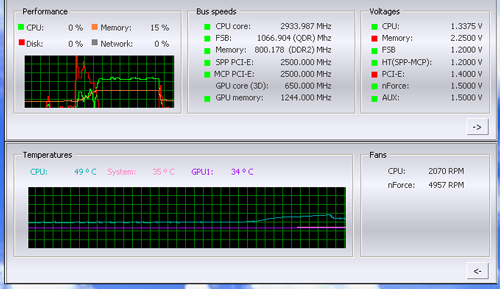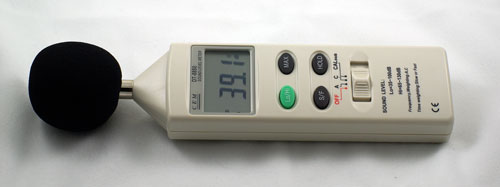Tuniq Tower 120: Air Cooling to the Max
by Wesley Fink on January 15, 2007 12:01 AM EST- Posted in
- Cases/Cooling/PSUs
CPU Cooling Test Configuration
A primary requirement for any cooling test bed is a reliable utility for measuring CPU temperature and fan speed. The utility also must be usable while other programs are running so the impact of stress testing can be assessed. It is not really critically important that the temperature measurements be completely accurate, but results must be consistent and repeatable using the same test setup.After assessing a number of Intel 975/965 and NVIDIA 680i motherboards the decision was reached to use the NVIDIA 680i as the cooling test bed. This was primarily based on the excellent temperature measurement utility, NVIDIA Monitor, which is part of the nTune program.

NVIDIA Monitor has a drop-down pane for temperature measurement which reports CPU, System, and GPU measurement. At this point we will concentrate primarily on CPU temperature with listings of system temps for reference. In addition to the real-time temperature measurement, NVIDIA Monitor also has a logging feature which can record temperature in a file in standard increments (we selected every 4 seconds). This allows recording of temperatures during testing and play back, for example, of stress test results that can then be examined when the stress tests are completed. There is also the handy reference of speeds and voltages in the top pane to confirm the test setup. These factors made NVIDIA Monitor on the 680i the ideal program for evaluating cooling.
Further tests using the program showed results were consistent over the same setup and repeatable under similar conditions. For all of these reasons NVIDIA Monitor on the NVIDIA 680i was used for testing cooling. Other components in the cooling test bed are generally the same as those used in our motherboard and memory test bed:
| Cooling Performance Test Configuration | |
| Processor: | Intel Core 2 Duo X6800 (x2 2.93GHz, 4MB Unified Cache) |
| RAM: | 2x1GB Corsair Dominator PC2-8888 (DDR2-1111) |
| Hard Drive: | Hitachi 250GB SATA2 enabled (16MB Buffer) |
| Video Card: | 1 x EVGA 7900GTX - All Standard Tests |
| Platform Drivers: | NVIDIA 9.53 |
| Video Drivers: | NVIDIA 93.71 |
| CPU Cooling: | Tuniq Tower 120 Intel Stock HSF for X6800 |
| Power Supply: | OCZ PowerStream 520W |
| Motherboard: | EVGA 680i SLI (nVidia 680i) |
| Operating System: | Windows XP Professional SP2 |
| BIOS | Award P23 (12/22/2006) |
The 680i motherboard with NVIDIA Monitor software will allow testing of the cooling efficiency of the cooler under test. We first tested the stock Intel cooler at standard X6800 speed, measuring the CPU temperature at idle and while the CPU was being stressed. We stressed the CPU by running continuous loops of the Far Cry River demo. The same tests were repeated at the highest stable overclock we could achieve with the stock cooler. Stable in this case meant the ability to handle our Far Cry looping for at least 30 minutes.
The same tests were then run on the cooler under test at stock, highest stock cooler OC speed, and the highest OC that could be achieved in the same setup with the cooler being tested. This allows measurement of the cooling efficiency of the test unit compared to stock and the improvement in overclocking capabilities, if any, from using the test cooler.
Noise Levels

In addition to cooling efficiency and overclocking abilities, users shopping for CPU cooling solutions may also be interested in the noise levels of the cooling devices they are considering. Noise levels were measured in various configurations using a C. E. M. DT-8850 Sound Level meter. The C. E. M. meter can measure either A-weighted or C-weighted sound levels. All reported measurements are A-weighted since this is generally considered closer to the way the human ear actually perceives noise.
This meter allows sound level measurements from 35bdB to 130dB with a resolution of 0.1dB and an accuracy of +/- 1.5dB. This is sufficient for our needs in these tests, as measurement starts at the level of a relatively quiet room. Our own test room, with all computers and fans turned off, has a room noise level of 36.4dB. Our procedures for measuring cooling system noise are described on page 6 along with noise results comparing the stock Intel cooler to the Tuniq Tower 120.










50 Comments
View All Comments
LoneWolf15 - Monday, January 15, 2007 - link
Thanks Wesley, for the review.I'd love to see a complete "cooling tower" review. There are a lot of similar products out there, such as the Sycthe Ninja/Scythe Infinity family, a couple by Noctua, the CoolerMaster Hyper 6+, Arctic's Freezer Pro line, and (sort of similar) Zalman's 9500/9700 line. A lot of us would like to know how they stack up against each other on both Intel and AMD platforms, with the following notes:
Weight of each cooler (lighter being better if it doesn't sacrifice performance)
Ease of mounting on both AMD and Intel systems (with a key to whether the heatsink can be mounted properly for fan exhaust direction, regardless of socket orientation on the mainboard)
Noise level
Cooling effectiveness
Smoothness of CPU mating surface
I've been tempted to buy a tower heatsink/fan unit, as I think it will cool better than my good, but aging Swiftech MCX64-V, since if chosen correctly, a new model should blow air straight to the 120mm exhaust fan at the back of the case. However, I haven't seen a good side-by-side comparison yet that tells me everything I'd wish to know. I hope Anandtech will look into this. Thanks!
AlabamaMan - Monday, January 15, 2007 - link
More pictures would have been very helpfull. I have an e680i mobo and Lian-Li A10 case I still can't fiure out if I can put in the Tower without hitting the top-mounted 120mm case fan.Wesley Fink - Monday, January 15, 2007 - link
If the fan is really at the top, and not at the side of the case (in a tower design) the concerns are different. Considering dimensions toward the physical top (long dimension or height of a tower case), the Tuniq width in that direction is 110mm or 4.3". You can measure from the center of the socket 775 to see if you have 55mm (2.165") clearance to your fan from the center of the socket to the edge of the fan. Just for info the top of the Tuniq is 110mm x 128mm (4.3" x 5").Wesley Fink - Monday, January 15, 2007 - link
The Tuniq Tower dimentions are on page 3. A normal case is 19cm (7.5") deep in the cooler dimension, while the Tuniq is 15.5cm (6.1") tall. I can tell you for a fact the Tuniq clears all components on the 680i baord and can even be used with tall memory mounted (Corsair Diminator for example). You will need to determine if 1.4" is enough clearnace for you fan. Also since the fan would be blowing down on the solid top of the Tuniq, it likely will accomplish nothing as far as cooling is concerned and should be removed.Additional information about the size of the Tuniq can be found at www.tuniq.com
mackintire - Monday, January 15, 2007 - link
I m pretty sure the Tuniq Tower 120 is the best air cooled heatsink.I have a Intel Core 2 Quad QX6700. I do have a Scythe Ninja on it with a scythe 1600rpm S-fan. Running 2 instances of Orthos on all four cores gave me a full load temp of 74C and I know I have too much artic silver 5 on it. So realistically my load temps should be 73-72C.
I just purchased a Noctua NH-U12F which I believe to be really close to the performance of the Tuniq Tower 120.
I think we definately need the Noctua NH-U12F in the best cooler roundup.
The ninja need to be there for reference. And the Scythe Infinity would be a good idea too.
Another item of note is that these larger heavier CPU's show a different delta when loaded up with super hot CPUs.
My quad core running at 3.2 produces mega heat that few heatsinks can deal with.
The reason I switched to the NH-U12F was that it dropped my temp by 8C at stock speeds. 2 C of that I blame on properly application of artic silver.
Either way, this heatsink was well worth the money to me.
mackintire - Monday, January 15, 2007 - link
I changed over to the Noctura this past weekend. Just clearing up my previous post.The Ninja is an excellent heatsink, but I think that there is a limit as to how much heat a heatsink can deal with. I have noticed more recently with the current round of newer solutions that the coolers with more mass tend to deal with larger heat loads better. This is not an exact trend, I m just saying that I haven t found any 300g heatsinks that can perform as well as the better 700g heatsinks under heavy heat loads.
baronzemo78 - Monday, January 15, 2007 - link
Does anyone know how the thermal grease that comes with the Tuniq compares to Arctic Silver 5? Also I would love to see an Andantech article about lapping. I have seen some articles that say that lapping doesn't really improve your temps that much.http://www.overclockers.com/tips458/">http://www.overclockers.com/tips458/
Araemo - Monday, January 15, 2007 - link
Lapping was much more important on Pentium 3s and Athlons that had an exposed CPU Die, and no heat spreader.On modern Intel and AMD CPUs with a heat spreader, the thermal transfer point that needs the highest efficiency is between the heat spreader and the die - you can't do anything about that. The heat spreader gives you much more surface area to transfer the heat with, so the small increase from lapping isn't nearly as important as it used to be.
Perhaps if you're using a Tuniq Tower w/ a super high speed fan and an AC unit blowing at your case inputs and you're trying to break 4Ghz.. it might help. But for us real people, I'd say you're better off spending the time/money on a case with better airflow dynamics or just tying your cables out of the way to maximise airflow.
I have lapped a couple heatsinks, one I did a real half-assed job on, and temps were disappointing(lower than OEM heatsink, but higher than I would have liked).. my last one was used to overclock an AthlonXP mobile from 1.8 to 2.4, and I daresay it helped, but as I mentioned, those AthlonXPs had exposed CPU dies, so you had to transfer the full 60W or whatever using .5 square centimeters of surface area, so improving the transfer rate in any way possible helped.
mino - Monday, January 15, 2007 - link
Please consider doing the tests on Quad CPU(Kentsfield) as well as on a Duo CPU.Many coolers while beeing great for C2D perform poorly on Quad and vice versa.
Avalon - Monday, January 15, 2007 - link
I'd like to see the Coolermaster Hyper TX included if possible!Good review!